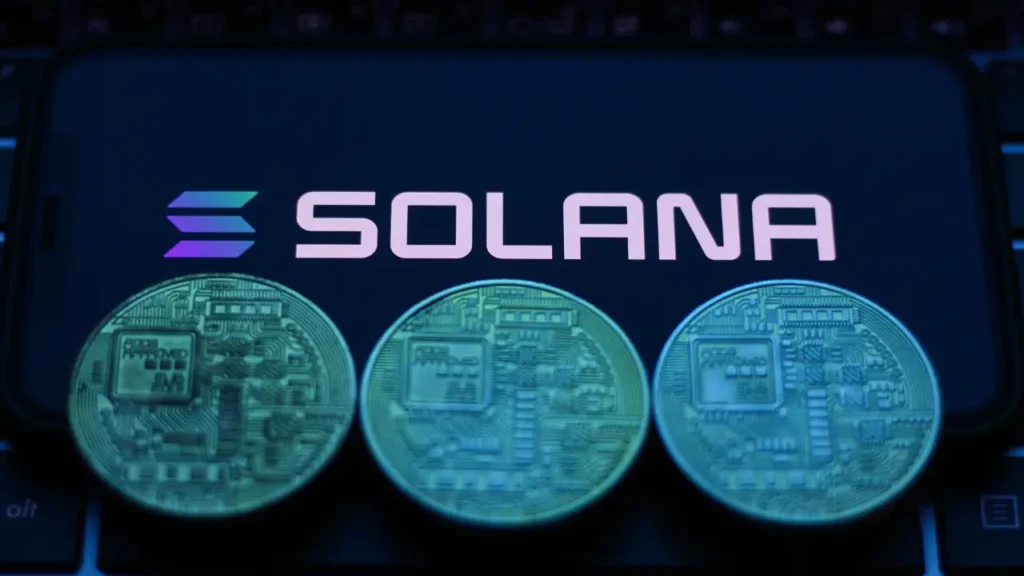Yield farming is a passive income strategy exclusive to DeFi systems and protocols. Join us in this article as we walk you through yield farming across chains.

As DeFi continues to make waves and grow rapidly since the summer of 2020, yield farming is a popular tool for generating profits on long-term investment.
Yield farming is staking your assets on a platform to gain yield, typically through governance tokens or staked assets.
As new platforms are introduced into the ecosystem regularly, yield farmers continuously look for the best returns. Traditionally, this is equivalent to placing monies into the bank with the highest interest rate, albeit with considerably larger figures.
With the Ethereum network becoming increasingly clogged, gas prices have risen considerably, even for simple transactions.
The increase in gas fees has discouraged many users from using the Ethereum blockchain because it is no longer economically viable.
DeFi activity on Ethereum is now primarily reserved for larger whales, who have hundreds of thousands of dollars at their disposal and can easily cover their transaction costs in little to no time.
Although one of the primary goals of yield farming, barring exorbitant incentives, has been to ensure a fair distribution of rewards, the hurdles to entry have simply grown financially prohibitive for those with less wealth.
This problem has sparked a wave of yield farming activity on alternative networks such as Binance Smart Chain (BSC) and some others, where transactions can range from a few cents to a couple of dollars.
While whales can continue to flock to BSC and collect their return, decreasing transaction costs has made participation economically possible for novices and developers.
Let us take a deep dive into yield farming across chains.
Yield Farming Across Chains
Some of the platforms yield farming across chains take place include;
- Binance Smart Chain (BSC)
- Avalanche (AVAX)
- Polygon (MATIC)
- Solana (SOL)
Binance Smart Chain (BSC)

There are various options for putting funds on the Binance Smart Chain. Here, we’ll outline two of the most prevalent methods:
Withdraw funds from Binance to Binance Smart Chain.
Binance users can withdraw funds directly to their BSC Wallets. Check that the funds are compatible and available on BSC and that you have chosen the suitable network to withdraw them.
Take note of the fee differences between networks. Withdrawals from BSC cost only about 20 cents, compared to the Bitcoin and Ethereum networks, which cost around $25 and $15, respectively.
Transferring funds Using the Binance Bridge
Alternatively, you can use the Binance Bridge to move funds between the Ethereum, TRX, and Binance Smart Chain networks. It is important to note that only particular assets are supported by each network, and there is a daily limit on how much you can send to BSC.
Understanding that the Binance Smart Chain does not operate without gas is vital. BSC employs Binance Coin (BNB) as its native token for gas fees, similar to how Ether is used to pay Ethereum transaction fees.
As a result, send some BNB to your BSC wallet before you begin your yield farming adventures.
Avalanche (AVAX)

With the recent launch of the $180 million ‘Avalanche Rush’ incentive scheme, the Avalanche network has emerged as the new hub for DeFi activity, with additional projects sprouting up on the C-Chain since the announcement.
Power DeFi customers were among the first to cross the bridge to Avalanche, discovering a new world of projects that felt all too familiar.
Although the Avalanche network has not gained much traction since its mainnet launch in September 2020, the AVAX incentives have proven to be a strong catalyst for increasing attention to the ecosystem.
This provides a fantastic opportunity for early users to learn about and play with the network’s native DeFi and yield farming protocols before Aave and Curve arrive.
Step 1: Add Avalanche to Metaverse
- Go to https://chainlist.org/ and connect your wallet
- Search for Avalanche Mainnet and click ‘Add to MetaMask.’
- You will receive a prompt from MetaMask to allow the site to add the network. Click on Approve
Congratulations! You! You have successfully set up the Avalanche C-Chain network in your MetaMask wallet! Do note that you cannot use your MetaMask wallet to access the X-Chain as it requires the usage of their native wallet here.
Step 2: Load Your Metamask Wallet With Assets
- Create an Avalanche wallet at https://wallet.avax.network. The wallet will include unique addresses for accessing the X-Chain, C-Chain, and P-Chain. Remember that your X-Chain address will change with each deposit.
- To withdraw from Binance/Kucoin, log in to your account and choose the withdrawal method. It should be noted that this withdrawal method is only available for AVAX.
For Kucoin, you can pick between the Avax native network (X-Chain) and the Avax C-Chain. Enter your X-Chain address and select the amount you want to withdraw.
If there are no traffic or service interruptions, you should be able to see your AVAX in your X-Chain wallet within a few minutes. X-chain addresses begin with the letter X, but C-chain addresses start with ‘0x’, just like EVM-blockchain addresses do.
- Once the funds are in your X-Chain address, you can export them by selecting the ‘Cross-Chain’ tab on the left side of the wallet screen.
Make sure to choose X-Chain as the source and C-Chain as the destination. You’ll also have to pay a minor fee to export and import AVAX between chains.
- After the funds have been imported onto the C-Chain, you can transfer them to your MetaMask address and interact with the numerous dApps on Avalanche. If you need to return your cash to the exchange, click ‘transmit’ and pick the source chain where they are now located.
That concludes the matter! You’re now ready to start farming Avalanche and earning those juicy yields! But before you start walking down the icy path, you should know a few things.
On Avalanche, payments are made with the native token of the network, which is then burned after the transaction. You would need to transmit some AVAX in this situation; the amount needed would depend on the kind of transaction.
Dynamic fees are used by the Avalanche C-Chain and are established following the network’s utilization. Gas fees can reach 225 gwei, or about 0.03 AVAX, for a standard swap transaction when the network is busy.
Compared to Polygon or Binance Smart Chain, this would work up to roughly $1 for every transaction. Still, yield farming aggressively on Avalanche is significantly more inexpensive than on Ethereum.
Polygon (MATIC)

Interestingly, only a few Ethereum addresses have interacted with the sidechain. Nansen’s analysis shows that less than 0.1% of addresses on the Ethereum mainnet are also on Polygon.
This vast untapped opportunity is ready for a Cambrian growth and yield farming activity explosion.
Before you begin your journey, you will need a wallet to store your funds.
Like most EVM-compatible blockchains, the Polygon network may be readily added to your existing MetaMask wallet by going to chainlist.org and selecting the Matic Mainnet option.
With your wallet set, it’s time to start loading it with funds. There are several methods that you can use to transfer your assets. Here, we will discuss just one of them.
Transferring from xDAI via Xpollinate
Step 1: Navigate to https://www.xpollinate.io/ and switch to your chosen network.
Step 2: Select the asset you want to transfer and enter the receiver’s address. Once that’s done, click ‘Swap’. This bridge currently only supports DAI, USDC, and USDT.
Step 3: You will then be prompted to log in to Connect while the bridge configures channels for the transfer. Next, a swap interface will appear, allowing you to enter the amount you want to port over. Once you’re done, click ‘Swap’.
Step 4: Wait for the transfer to be completed, and you should be able to view your assets on Polygon.
It should be noted that this bridge may not always be available, depending on the liquidity levels on both sides. The exit liquidity for transfers is displayed underneath the leading site’s interface.
That is all there is to it! Now, you’re ready to start farming those delicious yields on the Polygon. But wait, you should know a few things before you start your voyage.
Transactions are compensated for using the network’s native token, as with most other blockchain-based applications. In this situation, you’ll need to transfer some MATIC, yet even one MATIC can survive for thousands of transactions.
For example, with MATIC currently hovering about $1, most transactions require a gas fee of only 1 gwei, meaning you’d pay less than a tenth of a cent to approve, transfer, or swap assets on Polygon.
As you can see, this tremendously advantages smaller farmers with limited resources because transaction costs, which are typically a barrier to entrance on Ethereum, are no longer present.
Solana (SOL)

Unlike most blockchains, which may be accessed via a conventional Metamask or hardware wallet like Ledger or Trezor, Solana supports a variety of wallets for holding funds. These wallets include Sollet, Solong, and MathWallet.
These wallets are all non-custodial, which means you have control over your cash, and they may be used to receive and transmit SOL or any other Solana Program Library (SPL) tokens.
Although all of them can be utilized without trouble, we recommend utilizing the Sollet wallet developed by the Project Serum team because it is very compatible with most, if not all, of the projects now live on Solana.
How To Create a Sollet Web Wallet
The following is a step-by-step instruction for creating a Sollet web wallet.
Step 1: Visit https://www.sollet.io/. You’ll be prompted to establish a new wallet if it’s your first time. You will be provided with 24 seed words, which you must restore your wallet if you lose access.
Once you’ve confirmed that your seed words were stored correctly, click the checkbox and select ‘Proceed.’ If you already have a Solana wallet created somewhere else, you can also restore it.
Step 2: You can add a password as an added degree of security. Before you can create your wallet, type in and confirm your password. You may skip the password step and make your wallet immediately.
However, we recommend using a password to reduce the possibility of losing your cash.
Step 3: Congratulations! Your wallet has been created! You may view your account’s asset balances and addresses here.
Step 4: Remember that, unlike regular Metamask wallets, each with its unique address, you will have separate addresses for receiving and transmitting various assets throughout the Solana blockchain.
To add a token, click the ‘+’ symbol, and you will be presented with a list of tokens to pick from. You may also enter the token details manually. Regardless, adding token addresses will incur a minor fee of 0.002039 SOL.
Conclusion
Yield farming allows web3 users to profit from their spare assets by offering liquidity to decentralized protocols. This is one of the most significant trends in DeFi.
Yield farming across chains improves the benefits of regular yield farming in cryptocurrency by allowing you to use many protocols simultaneously without being limited by unnecessary costs.
As a result, you can triple your benefits without being penalized for being proactive and take advantage of all available chances through cross-chain yield aggregators.
